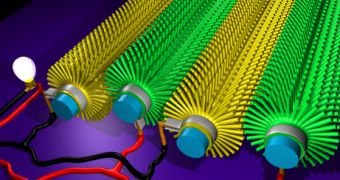One day, your shirt could be a power plant as well. Intelligent nanotech fabrics could harvest energy from motion to charge power portable electronics, based on the piezoelectric effect. The new material has been developed and described in the journal "Nature" by a team led by Zhong Lin Wang, at Georgia Institute of Technology.
The piezoelectric effect takes place when pressure is applied to certain matters with crystalline structures, resulting a small electric charge. The new textile fibers have piezoelectric nanowires set like the bristles on a bottlebrush. Just by moving, you rub the piezoelectric wires, producing electricity, up to 80 milliwatts for square meter (11 square ft) of material. This is not enough for music players or cell phones, which require at least several hundreds milliwatts, but it could work for tiny sensors tracking your vital signs.
"And the use is not limited to clothing. The technique can be applied to any surface that picks up vibration, such as engines, tires, or even swaths of cloth catching the wind," said Wang.
The team achieved nanowires of zinc oxide, 50 nanometers thick (1/1,000 of the width of a human hair), wrapping Kevlar fibers.
"You can grow this wire on any substrate, even on your hair. The wires would make your hair look gray, but it would feel largely the same," said Wang.
This Kevlar was used to make the fabric. The electric charge is collected by electrodes at the bases of the fibers. "While Wang's team is not the first to harness the piezoelectric effect, they have found a way to produce such material in large quantities," said Min-Feng Yu, a nanoelectronics expert at the University of Illinois, Urbana-Champaign.
Nanosensors could be placed in the bloodstream to detect early emergence of diseases, or to be inserted into soldiers' uniforms or athletes' clothing to monitor their vital signs during combat or competition. They could also monitor environmental factors.
"One thing [nano-sensors have] in common is that each of these things needs power. Conventional batteries are still too large, but piezoelectric generation would be perfect for these applications. Any nano-device will consume very little power. Why don't we take an advantage of that?" Wang said.

 14 DAY TRIAL //
14 DAY TRIAL //